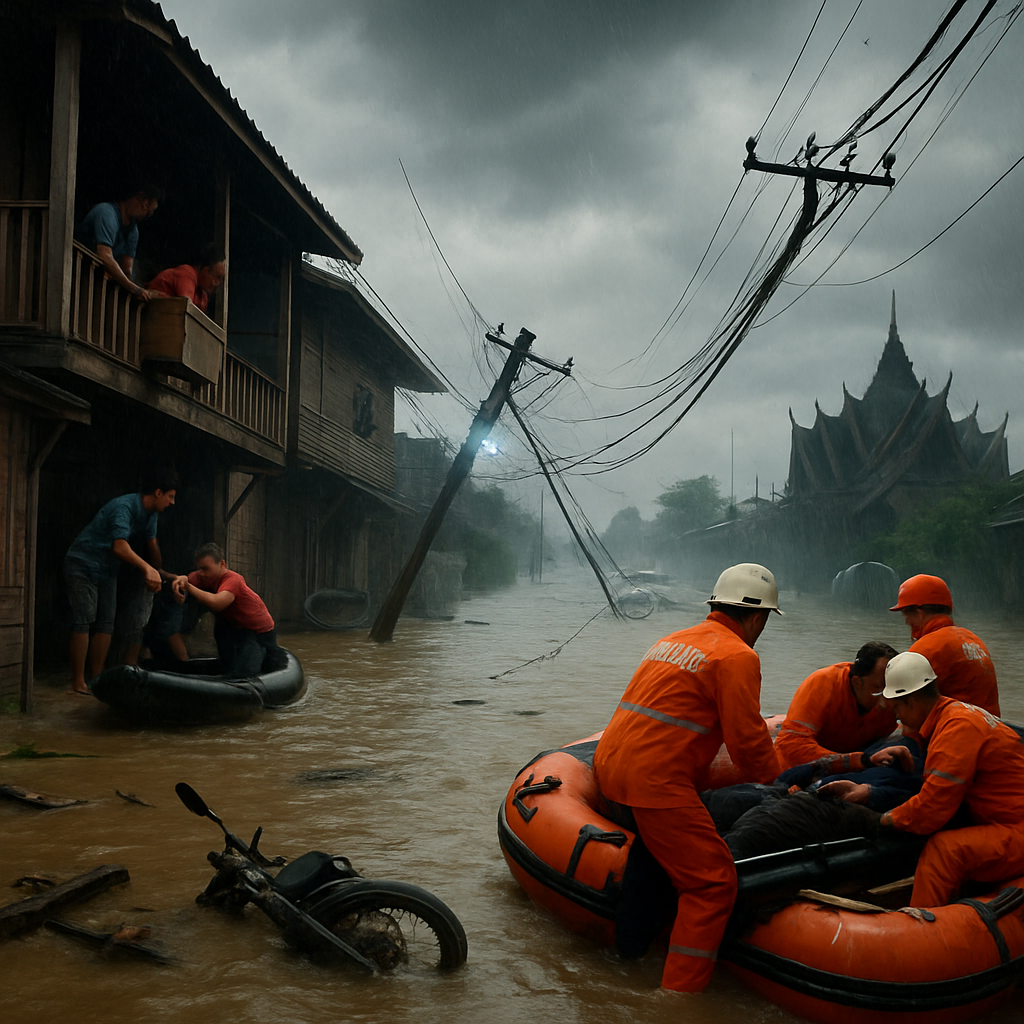Floodwaters that swept through Nakhon Si Thammarat last week turned a frantic scramble into a tragedy when an electrical leak claimed one life and left eight people injured as families hurriedly moved possessions to higher ground. The horror unfolded in Chaloet and Tha Pracha subdistricts late on Thursday, November 20, as residents battled rising water, collapsing calm and, tragically, live power in submerged homes.
The moment everything went wrong
By late afternoon on November 20, rain that had been hammering the province since November 17 reached a tipping point. Runoff from the Luang Mountain range swelled the Tha Dee Canal in Kamphaeng Sao subdistrict, which then burst its banks and sent a fast-moving wall of water into Nakhon Si Thammarat municipality. Streets that are usually bustling—like Thevaburi Road, the main route to Pho Sadet—were waist-deep in places, impassable for small vehicles and littered with the detritus of a community racing to protect what they could.
Amid this chaos, eight people were electrocuted inside a residence in Tha Pracha as they attempted to escape the rising water. Rescuers from the Siam Rescue Unit arrived to find four victims unconscious and in critical condition. Emergency teams performed CPR at the scene before rushing everyone to Chaloet Hospital. Three of the most severely injured were later transferred to Maharaj Nakhon Si Thammarat Hospital for advanced care. One person did not survive—the first confirmed death in a series of storm-related incidents that have battered the southern province.
Widespread flooding, wide-ranging danger
The electrocution incident is part of a much larger emergency that has affected 12 districts across Nakhon Si Thammarat: Mueang, Cha-uat, Tha Sala, Phrom Khiri, Thung Song, Ron Phibun, Na Bon, Sichon, Chawang, Chaloem Phra Kiat, Hua Sai and Lan Saka. Cha-uat, on the province’s western flank, has been especially hard hit: residents there endured another frightening electrical short circuit during the same bout of heavy rain, and emergency services have reported overlapping incidents as the flood response stretches resources thin.
Local media and officials note that the most dangerous element in many of the affected homes is hidden beneath the murky surface—live wiring and short circuits made lethal by standing water. When floodwaters submerge electrical sockets, appliances and wiring, even a routine attempt to unplug a TV or drag a soaked refrigerator to safety can become deadly.
Rescue teams under pressure
Emergency services are coordinating across subdistricts as teams respond to calls, evacuate residents and assess structural damage. With roads like Thevaburi rendered unusable by 30 centimetres of water in places and streams of water funnelling into populated neighborhoods, first responders face hazardous conditions just getting to the people who need help.
Officials are urging residents to remain indoors where safe, avoid wading through floodwater, and report any signs of electrical hazards—sparks, burning smells, exposed live wires—immediately to local authorities. Power crews are working to isolate risks, but the scale of flooding makes it a race against time and weather.
How to stay safe if floods strike your home
Natural disasters are frightening, but a few practical steps can reduce the risk of electrical tragedy when floods arrive:
- Turn off the main circuit breaker if you can safely reach it without stepping into water.
- Never touch electrical appliances or outlets while standing in water; even seemingly switched-off devices can be live.
- Avoid wading into floodwater if possible—there may be submerged hazards, open manholes or live cables.
- Move family members, pets and valuables to higher ground early—don’t wait until the water is at your doorstep.
- Report downed lines, sparking outlets or burning smells to emergency services immediately.
What’s next for Nakhon Si Thammarat
With weather forecasts predicting more rain in the coming days, local officials are continuing relief efforts and closely monitoring rivers, canals and mountain runoff. Temporary shelters, coordination with hospitals and ongoing rescue operations remain priorities as communities count losses and try to keep themselves safe from further harm.
The loss of life and the injuries sustained are stark reminders that floods don’t just sweep away possessions—they can uncover hidden dangers inside the home. If you live in or near flood-prone areas, now is the time to make an evacuation plan, secure important documents and heed all warnings from local authorities. The people of Nakhon Si Thammarat are fighting back against the rising water; staying alert, informed and cautious about electrical risks will save lives.
If you have family or friends in the province, check on them, share this safety information and follow updates from official channels. In an emergency, every precaution, every early move and every phone call can make the difference between a close call and a tragedy.


















This is horrific and predictable; the power company should have cut electricity before the flood reached homes. Turning off the grid in vulnerable areas during heavy storms is basic disaster planning. Someone needs to be held accountable for this preventable death.
Blaming the power company alone ignores how bad the drainage and urban planning are here. These repeated floods are a symptom of years of ignoring infrastructure and rapid development without thought.
You’re right that planning failed, but the immediate electrical risk was acute and avoidable. Utilities and local authorities should have a clear emergency cutoff plan they execute automatically.
As someone living near the canals, I can tell you the water rises so fast you barely have time to move things. We need simple measures like raised outlets and community breakers so ordinary people aren’t frying when they try to save a TV.
Raised outlets are a great practical idea and inexpensive compared to losing loved ones. Why are these basic safety upgrades not being funded for poor neighborhoods?
This tragedy also shows how public messaging fails; people panic and do the wrong thing when no clear instructions are issued. Local authorities must broadcast simple, repeated safety steps during floods so families know not to touch appliances in water.
I grew up in a town that fixed drainage after one bad flood and never looked back. Here, politicians promise action after each disaster and then nothing changes, which is infuriating and deadly.
Political will matters, but technical solutions exist: better retention basins, restored wetlands and updated building codes would reduce flood peaks. Funding and enforcement are the real bottlenecks.
Absolutely, Helen. It’s not rocket science, it’s bureaucracy and graft that stop implementation. Voters need to demand concrete timelines and audits.
Audits are fine but on-the-ground response matters now; rescue teams were stretched thin and could not reach some neighborhoods. Long-term fixes are necessary but people need immediate help and accountability.
Farmers and small homeowners have been saying for years that canals need regular dredging. When the mountain runoff comes it overwhelms the system and everything behind it suffers.
Dredging helps short-term but isn’t sustainable alone; combining nature-based solutions like reforestation with engineered channels reduces the risk more effectively. Policymakers must plan for both immediate relief and long-term resilience.
Thanks, Maya. Long-term is fine but we still need someone to schedule the dredging next month so my village doesn’t flood again. Practicality matters when your home is at risk.
Electrocution in floods is often due to inadequate isolation of circuits and lack of ground-fault protection. Modernizing household wiring, installing GFCIs, and ensuring main breakers are accessible above floor level would save lives.
Can you point to examples where such upgrades dramatically cut electrocutions in floods? Readers want evidence before asking for costly retrofits.
Yes, there are case studies from flood-prone regions showing reduced fatalities after mandatory GFCI installation and community education. The upfront cost is small compared to funeral expenses and medical care.
If these are proven solutions, why aren’t utilities offering free checks or subsidies to install GFCIs in poor homes? This seems like an easy policy win before the next storm.
My heart goes out to the family who lost someone; this is devastating and avoidable. I hope shelters and hospitals get enough support in the coming days.
Rescue teams did the best they could but roads were impossible and coordination faltered across districts. We need a national emergency fund for rapid deployment so local units aren’t left begging for boats and fuel.
A national fund would help, but transparency is essential; money disappears without strict procurement rules and civil society oversight. Build the fund with accountability from day one.
Agreed, Kumar. The fund should be tied to public reporting portals and independent audits published within weeks. Otherwise it’s just another promise.
You’re all talking around the real issue: corrupt contractors and politicians pocket disaster relief while people die. Why is anyone surprised that infrastructure fails?
Accusations of corruption are easy, but let’s focus on immediate support for victims now. Pointing fingers helps later but people need shelter, food and medical care tonight.
Community-level interventions like neighborhood watch teams trained to identify electrical hazards could reduce immediate deaths. Empowering locals with simple tools and training is cost-effective and quick.
That’s a smart idea but training requires funding and regular drills, which are rarely prioritized unless a disaster is fresh in voters’ minds. Sustained commitment is the hurdle.
Exactly, Larry. We need ongoing programs, not one-off training sessions that fade away. Embed them in schools and local clinics for lasting impact.
Our reporting tried to balance urgency with accuracy, but readers keep asking why more people weren’t warned about live wiring. We’ll follow up on protocols for power shutdowns and public alerts. Please share any eyewitness accounts.
The article was good but the headline made it sound like an unavoidable accident rather than a systemic failure. Tone matters when mobilizing accountability.
Point taken, Joe; we’ll probe utility decision-making and include expert commentary on preventable measures. Transparency is part of our job and we take it seriously.
Thanks for covering it responsibly. Media attention often drives quick fixes, even if temporary, so keep the pressure on authorities.
This makes me so sad; I lost a friend in a flood years ago and the fear never leaves you. Please everyone check on neighbors and elders who might try to move heavy appliances in panic.
There should be legal consequences for utilities and landlords who ignore flood-risk wiring standards. When negligence leads to death, prosecution must be on the table.
Prosecution might be warranted in some cases, but we must ensure investigations are evidence-based and not politically driven. Technical forensics can determine whether standards were breached.
Forensics are fine, but make them fast and public. Too often inquiries drag on and nobody faces consequences, and the same mistakes repeat.
I think these incidents are cyclical because of a culture of impunity; companies cut corners and the public foots the bill. Until people at the top are punished, nothing will change.
Blame is easy, Karen, but solutions need technical and political action. Threatening vague punishment without clear legal process won’t protect anyone next storm.
Fair point, but I also want whistleblowers protected and swift inquiries into procurement for drainage and power projects. Transparency can prevent the worst corruption.
We must frame this within climate adaptation: more extreme rainfall events are likely and infrastructure must be stress-tested. International cooperation and funding can help, but local governance must use resources well.
Integration of climate science into urban planning is non-negotiable now. Planners need updated models and the political will to implement resilient designs.
Exactly, Maya. It’s about embedding resilience into budgets and laws so every new road and housing estate considers future flood risk.